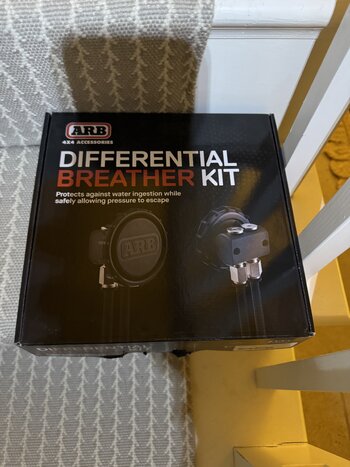Maybe? But I won’t be spraying that filter with water, and it’s super protected from splashing.
The Grenadier Forum
Register a free account today to become a member! Once signed in, you'll be able to contribute to the community by adding your own topics, posts, and connect with other members through your own private inbox! INEOS Agents, Dealers or Commercial vendors please contact admin@theineosforum.com for a commercial account.
Diff breathers
- Thread starter RTG
- Start date
For that coner case a viable solution would be to maintain a slight (regulated to approx. 500mm water depth or 5 kPa) overpressure using a pressure reducer and a small compressed air reservoir from which you can draw clean air in case the diff is quickly cooled down and hence would otherwise create an underpressure inside.If one is using atmospheric breathers, there is an unfortunate corner case where you might have worn seals (but not actually failed) and the water will be pushed through because of the pressure difference while submerged. This would not happen with the original breather.
Diff breathers position, NOT raised air intake as it's not a snorkel!
The concept of any water crossing (ocean or river) is 'pushing' a body water in front of the vehicle at moderate speed. With a good bow wave, the engine bay is not entirely filled.
With experience, the optimal position for diff breathers is the highest position on the fire wall just under the bonnet. An added blind / tarp over the front really helps (old school).
Oh yes, I learnt the hard way drowning my first 4x4 in 1982 after heavy rain while not having a clue following the trip leader wrong tyres, not able to drive up the embankment, then reversing back up stream finding a huge hole!!
Like in factory fuel or air filters, don't entirely trust factory breathers is either especially heavy off road use or when facing multiple water crossings near wheel depth.
The Grenadier is truly a great 4x4, however it's not designed to be a submersible and the factory unsealed raised air intake is not a snorkel!
The concept of any water crossing (ocean or river) is 'pushing' a body water in front of the vehicle at moderate speed. With a good bow wave, the engine bay is not entirely filled.
With experience, the optimal position for diff breathers is the highest position on the fire wall just under the bonnet. An added blind / tarp over the front really helps (old school).
Oh yes, I learnt the hard way drowning my first 4x4 in 1982 after heavy rain while not having a clue following the trip leader wrong tyres, not able to drive up the embankment, then reversing back up stream finding a huge hole!!
Like in factory fuel or air filters, don't entirely trust factory breathers is either especially heavy off road use or when facing multiple water crossings near wheel depth.
The Grenadier is truly a great 4x4, however it's not designed to be a submersible and the factory unsealed raised air intake is not a snorkel!
I owned a Suzuki Sierra back about 40 years ago and was a member of the Sydney Landcruiser club.Diff breathers position, NOT raised air intake as it's not a snorkel!
The concept of any water crossing (ocean or river) is 'pushing' a body water in front of the vehicle at moderate speed. With a good bow wave, the engine bay is not entirely filled.
With experience, the optimal position for diff breathers is the highest position on the fire wall just under the bonnet. An added blind / tarp over the front really helps (old school).
Oh yes, I learnt the hard way drowning my first 4x4 in 1982 after heavy rain while not having a clue following the trip leader wrong tyres, reversing back streams not able to cross!!
Like in factory fuel or air filters, don't entirely trust factory breathers especially when facing multiple water crossings near wheel depth.
The Grenadier is truly a great 4x4, however it's not designed to be a submersible!
An old hessian bag under the bonnet catch was what I used for water crossings.
Flipped up onto the bonnet when not needed and down in front of the radiator when crossing water.
No snorkel or diff breathers
I went everywhere the Landcruisers went except once.
Water a bit deep and fast and I started to float away.
Opened the downstream door and let the water in.
She sank, hit bottom and drove out.
Very lucky indeed.
Very lucky! Great story though.I owned a Suzuki Sierra back about 40 years ago and was a member of the Sydney Landcruiser club.
An old hessian bag under the bonnet catch was what I used for water crossings.
Flipped up onto the bonnet when not needed and down in front of the radiator when crossing water.
No snorkel or diff breathers
I went everywhere the Landcruisers went except once.
Water a bit deep and fast and I started to float away.
Opened the downstream door and let the water in.
She sank, hit bottom and drove out.
Very lucky indeed.
Been reading this thread... Am I correct that, if you want to do away with the factory breather, you'll need to MacGyver the parts? By my count, the truck needs Rear, Transfer Case, Transmission & Front...
Had the same experience in the Wenlock with a Feroza. No trouble on the way north but a little off line heading south. With the flow from the left at least I could open the door easily; it would have been much harder if the flow had been from the right.I owned a Suzuki Sierra back about 40 years ago and was a member of the Sydney Landcruiser club.
An old hessian bag under the bonnet catch was what I used for water crossings.
Flipped up onto the bonnet when not needed and down in front of the radiator when crossing water.
No snorkel or diff breathers
I went everywhere the Landcruisers went except once.
Water a bit deep and fast and I started to float away.
Opened the downstream door and let the water in.
She sank, hit bottom and drove out.
Very lucky indeed.
Anyone sell a kit yet. Those m10 air fittings are a rare bird in the USA
Can't forget a mates Suzuki Swift (being very light), drifting sideways on a river crossing up in Kosciusko, we had to tie (front & back) to other 4x4s to safely cross. Then Dane driver and car drowned it again later on, was a rescue mission then.I owned a Suzuki Sierra back about 40 years ago and was a member of the Sydney Landcruiser club.
An old hessian bag under the bonnet catch was what I used for water crossings.
Flipped up onto the bonnet when not needed and down in front of the radiator when crossing water.
No snorkel or diff breathers
I went everywhere the Landcruisers went except once.
Water a bit deep and fast and I started to float away.
Opened the downstream door and let the water in.
She sank, hit bottom and drove out.
Very lucky indeed.
Another occasion in a metre deep in snow (with chains) after crossing the Murray River.
Most of us eventually learn both in driver experience & vehicles limitations.
Lessons learnt are essential
McMaster-Carr has many M10x1 PTC fittings.Anyone sell a kit yet. Those m10 air fittings are a rare bird in the USA
33A: breather plug inner valve version made of brass - Nostrali
There is a new video about Diff. Breathers by Aigle Off Road. The flow of air into the axle described there is exactly like what I experienced with my axles when I replaced the original breathers.
View: https://youtu.be/6w5a_i1z63U?si=PRXrK6kpSMHoB_Lr
- Local time
- 3:10 AM
- Joined
- Oct 2, 2023
- Messages
- 368
This answer. I am not rerouting my diff breathers to keep water out, I have faith the carraro breathers do this really well, too well actually, talking to my friends at Agile Offroad.This is what I learned many years ago:
The factory-installed differential breather - which is not raised but is located on the differential housing - can get clogged by driving thorough mud, or under other circumstances. If the breather gets clogged, and you are driving under conditions in which the inside of the differential is heating up, the rising pressure cannot escape through the breather. Under such conditions, differential oil typically gets forced down one axle shaft, and out the axle seal.
When driving through cold water, pressure inside the differential can drop. If the breather is plugged with mud or sludge, it is possible that the pressure will equalize by sucking water in through the axle and pinion seals.
The techs changing diff covers in the shop report pressures higher than expected as the stock cover is removed. They report air rushing from the axle housing when the cover seal is broken which could (and has) resulted in pinion seal leakage. They report this has happened on off roaded and not so off roaded rigs.
For me, getting the breathers up above above the point water may intrude is an added benefit.
Last edited:
Will look to fit to both axle breathers.
Transfer case and gearbox will search wjere theor tubes go and leave alone if as some people have mentioned routed up into the top of engine firewall.
Looked at fabricating my own manifold but by the time I'd priced all the bits n pieces the Arb one was similar.
Be gone pinion seal weeps and don't come back!!
Transfer case and gearbox will search wjere theor tubes go and leave alone if as some people have mentioned routed up into the top of engine firewall.
Looked at fabricating my own manifold but by the time I'd priced all the bits n pieces the Arb one was similar.
Be gone pinion seal weeps and don't come back!!
Attachments
where did you source your kit from?Will look to fit to both axle breathers.
Transfer case and gearbox will search wjere theor tubes go and leave alone if as some people have mentioned routed up into the top of engine firewall.
Looked at fabricating my own manifold but by the time I'd priced all the bits n pieces the Arb one was similar.
Be gone pinion seal weeps and don't come back!!
Arb kit from Winchester Gearwhere did you source your kit from?
Some extra M10x1 push to fit elbow joints sourced from T7 design. Incase 90 degree fittings work better
ptfe tape and washers already have

DIFF BREATHER KIT
DIFF BREATHER KIT SKU wg52 Code 170112 Specially designed to work with diffs and ARB air lockers. Specifically engineered to work with differentials
straight ones here

8mm Hose OD M10x1.0 Straight Male Push Fit Hose Fitting
Our range of Male Threaded Straight Push Fit Hose Fittings are made from high quality Nickel-Plated Brass & Polyoxymethylene (POM). These Straigh
8mm pipe
I bought straight and 90deg. PTC’s when building my kit. I felt the straight fittings allowed for a better tubing routeArb kit from Winchester Gear
Some extra M10x1 push to fit elbow joints sourced from T7 design. Incase 90 degree fittings work better
Last edited:
thanks for that .Arb kit from Winchester Gear
Some extra M10x1 push to fit elbow joints sourced from T7 design. Incase 90 degree fittings work better
ptfe tape and washers already have

DIFF BREATHER KIT
DIFF BREATHER KIT SKU wg52 Code 170112 Specially designed to work with diffs and ARB air lockers. Specifically engineered to work with differentialswww.winchestergears.com
straight ones here

8mm Hose OD M10x1.0 Straight Male Push Fit Hose Fitting
Our range of Male Threaded Straight Push Fit Hose Fittings are made from high quality Nickel-Plated Brass & Polyoxymethylene (POM). These Straighwww.t7design.co.uk
8mm pipe
tks Tom109, well noted. Will try for straights first.I bought straight and 90deg. PTC’s when building my kit. I felt the straight fittings allowed for a better tubing route
Similar threads
- Replies
- 2
- Views
- 690
- Replies
- 19
- Views
- 677
- Replies
- 0
- Views
- 111




